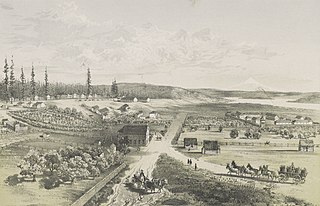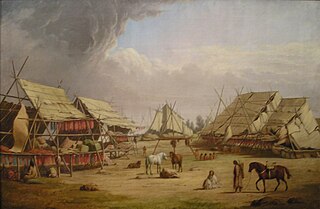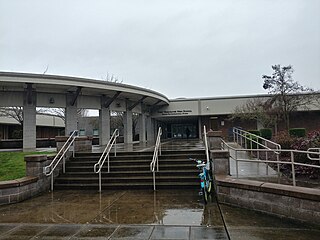
Fort Vancouver was a 19th-century fur trading post that was the headquarters of the Hudson's Bay Company's Columbia Department, located in the Pacific Northwest. Named for Captain George Vancouver, the fort was located on the northern bank of the Columbia River in present-day Vancouver, Washington. The fort was a major center of the regional fur trading. Every year trade goods and supplies from London arrived either via ships sailing to the Pacific Ocean or overland from Hudson Bay via the York Factory Express. Supplies and trade goods were exchanged with a plethora of Indigenous cultures for fur pelts. Furs from Fort Vancouver were often shipped to the Chinese port of Guangzhou where they were traded for Chinese manufactured goods for sale in the United Kingdom. At its pinnacle, Fort Vancouver watched over 34 outposts, 24 ports, six ships, and 600 employees. Today, a full-scale replica of the fort, with internal buildings, has been constructed and is open to the public as Fort Vancouver National Historic Site.

Fort McHenry is a historical American coastal pentagonal bastion fort on Locust Point, now a neighborhood of Baltimore, Maryland. It is best known for its role in the War of 1812, when it successfully defended Baltimore Harbor from an attack by the British navy from the Chesapeake Bay on September 13–14, 1814. It was first built in 1798 and was used continuously by the U.S. armed forces through World War I and by the Coast Guard in World War II. It was designated a national park in 1925, and in 1939 was redesignated a "National Monument and Historic Shrine".

Oregon Country was a disputed region of the Pacific Northwest of North America in the 19th century. The region was occupied by British and French Canadian fur traders from before 1810, as well as American settlers from the mid-1830s, with its coastal areas north from the Columbia River frequented by ships from all nations engaged in the maritime fur trade, most of these from the 1790s through 1810s being Boston-based. The Oregon Treaty of 1846 ended disputed joint occupancy pursuant to the Treaty of 1818 and established the British-American boundary at the 49th parallel.
The Confluence Project is a series of outdoor installations and interpretive artworks located in public parks along the Columbia River and its tributaries in the U.S. states of Washington and Oregon. Each art installation explores the confluence of history, culture and ecology of the Columbia River system. The project draws on the region's history, including Native American traditional stories and entries from the Lewis and Clark Expedition journals, to "evoke a landscape and a way of life submerged in time and memory." The project reaches from the mouth of the Columbia River to Hells Canyon.
New Caledonia was a fur-trading district of the Hudson's Bay Company that comprised the territory of the north-central portions of present-day British Columbia, Canada. Though not a British colony, New Caledonia was part of the British claim to North America. Its administrative centre was Fort St. James. The rest of what is now mainland British Columbia was called the Columbia Department by the British, and the Oregon Country by the Americans. Even before the partition of the Columbia Department by the Oregon Treaty in 1846, New Caledonia was often used to describe anywhere on the mainland not in the Columbia Department, such as Fort Langley in the Fraser Valley.

Fort Vancouver National Historic Site is a United States National Historic Site located in the states of Washington and Oregon. The National Historic Site consists of two units, one located on the site of Fort Vancouver in modern-day Vancouver, Washington; the other being the former residence of John McLoughlin in Oregon City, Oregon. The two sites were separately given national historic designation in the 1940s. The Fort Vancouver unit was designated a National Historic Site in 1961, and was combined with the McLoughlin House into a unit in 2003.

Fort Victoria began as a fur trading post of the Hudson’s Bay Company and was the headquarters of HBC operations in the Columbia District, a large fur trading area now part of the province of British Columbia, Canada and the U.S. state of Washington. Construction of Fort Victoria in 1843 highlighted the beginning of a permanent British settlement now known as Victoria, the capital city of British Columbia. The fort itself was demolished in November 1864 as the town continued to grow as a commercial centre serving the local area as well as trading with California, Washington Territory, the United Kingdom, and others.

The trade center Fort Colvile was built by the Hudson's Bay Company (HBC) at Kettle Falls on the Columbia River in 1825 and operated in the Columbia fur district of the company. Named for Andrew Colvile, a London governor of the HBC, the fort was a few miles west of the present site of Colville, Washington. It was an important stop on the York Factory Express trade route to London via the Hudson Bay. The HBC for some time considered Fort Colvile second in importance only to Fort Vancouver, near the mouth of the Columbia, until the foundation of Fort Victoria.

Established in 1849, the Vancouver Barracks was the first U.S. Army base located in the Pacific Northwest. Built on a rise 20 feet above the Hudson's Bay Company (HBC) trading station Fort Vancouver. Its buildings were formed in a line adjacent to the Columbia River about 2,000 yards from the water. It is now located within modern Vancouver, Washington.

Fort Vancouver High School, known as FVHS and Fort Vancouver High School Center for International Studies, is a public high school located in Vancouver, Washington. It is named after Fort Vancouver, an early trading outpost. The FVHS symbol is the Trapper, in reference to the fur trade in the early 19th century by such groups as Hudson's Bay Company voyageurs.
The 1925 Detroit Tigers season was a season in American baseball. The team finished fourth in the American League with a record of 81–73-2, 16½ games behind the Washington Senators.

Vancouver is a city on the north bank of the Columbia River in the U.S. state of Washington, located in Clark County. Incorporated in 1857, Vancouver has a population of 186,192 as of the 2020 U.S census, making it the fourth-largest city in Washington state. Vancouver is the county seat of Clark County and forms part of the Portland-Vancouver metropolitan area, the 25th-largest metropolitan area in the United States. Originally established in 1825 around Fort Vancouver, a fur-trading outpost, the city is located on the Washington–Oregon border along the Columbia River, directly north of Portland, and is considered a suburb of the city along with its surrounding areas.

The Father Millet Cross is a memorial on the grounds of Fort Niagara in Youngstown, New York. The 18-foot (5.5 m) bronze cross is a replacement for the wooden cross erected by Pierre Millet at the New French Fort Denonville in 1688. During the preceding winter, disease and starvation overwhelmed the fort's garrison of a hundred men and only twelve of them were saved by a rescue party. Father Millet, a Jesuit missionary, was with this rescue party. On Good Friday he celebrated Mass and erected and dedicated a cross invoking God's mercy for the plague-stricken men. On the beam of the cross is inscribed: "REGN. VINC. IMP. CHRS." an abbreviation for Regnat, Vincit, Imperat, Christus which is Latin for Christ reigns, conquers, and commands.

Pearson Field also once known as Pearson Airpark, is a city-owned municipal airport located one mile (2 km) southeast of the central business district of Vancouver, a city in Clark County, Washington, United States.
St. Luke's Episcopal Church is a parish of the Episcopal Church of America located in Vancouver, Washington. The parish is part of the Episcopal Diocese of Olympia and traces its roots to the initial arrival of Anglican worshippers at Fort Vancouver in the Oregon Country in the 1830s; its first dedicated church building was consecrated in 1860.

The Fort Vancouver Centennial half dollar, sometimes called the Fort Vancouver half dollar, is a commemorative fifty-cent piece struck by the United States Bureau of the Mint in 1925. The coin was designed by Laura Gardin Fraser. Its obverse depicts John McLoughlin, who was in charge of Fort Vancouver from its construction in 1825 until 1846. From there, he effectively ruled the Oregon Country on behalf of the Hudson's Bay Company. The reverse shows an armed frontiersman standing in front of the fort.

The Chkalov Transpolar Flight Monument, or simply Chkalov Monument, is a monument installed outside the Pearson Air Museum, in the Vancouver, Washington portion of the Fort Vancouver National Historic Site. The memorial commemorates the first transpolar flight, completed in 1937, and was dedicated in 1975.

The Monument to the Three Kichis is a memorial installed in the Vancouver, Washington portion of the Fort Vancouver National Historic Site, in the United States. The monument was dedicated on August 1, 1989.















